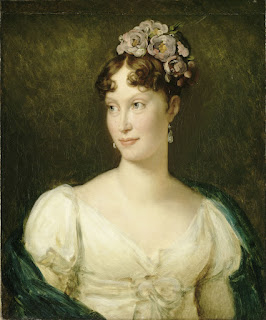Marriage to Napoleon earned Austrian noblewoman an Italian Duchy
 |
| Maria Luisa married Napoleon in 1810, two years before the French emperor's exile to Elba |
Despite being brought up to despise France, Maria Luisa agreed to marry Napoleon Bonaparte, the Emperor of France, by proxy in 1810. When she was asked for her consent, she replied: ‘I wish only what my duty commands me to wish.’ Fortunately, when she met Napoleon for the first time, she remarked: ‘You are much better looking than your portrait.’
She bore him a son in 1811, Napoleon Francois Joseph Charles Bonaparte, who was styled King of Rome at his birth and who later became Napoleon II.
After Napoleon’s failed invasion of Russia in 1812, the French ruler’s fortunes changed dramatically and he had to abdicate and go into exile on the island of Elba.
The 1814 Treaty of Fontainebleau gave the Duchies of Parma, Piacenza and Guastalia to Maria Luisa, who was to rule over them until her death.
To prevent Maria Luisa from joining Napoleon in Elba, the Emperor Francis II sent Count Adam Albert von Neipperg to accompany his daughter to the spa town of Aix-les-Bains. Maria Luisa fell in love with him and they became lovers.
 |
| A portrait of Maria Luisa with her son, Napoleon II |
She removed the existing Grand Chamberlain from office and installed Neipperg in his place, leaving the day-to-day running of the Duchy to him afterwards.
After Napoleon died in 1821, Maria Luisa married Neipperg, with whom she had three children. She was devastated when Neipperg died of heart problems in 1829.
He was replaced as Grand Chamberlain by the Emperor Francis II with another Austrian, Josef von Werklein, but in 1831 he was denounced by protestors who had gathered in the streets of Parma to show their opposition to him.
Maria Luisa asked her father to replace von Werklein and he sent a French nobleman, Charles Rene de Bombelles, who had served in the Austrian army against Napoleon, to be the next Grand Chamberlain of the Duchy of Parma.
He reformed the finances of the Duchy and developed a close personal relationship with Maria Luisa. They were married in 1834, just six months after his arrival in Parma.
Maria Luisa became ill in December 1847 and she died of pleurisy on the evening of 17 December in Parma, the city she had ruled over for more than 30 years. Her body was sent to Vienna, where she was buried at the Imperial Crypt.
 |
| Prosciutto di Parma ham is one of the gastronomic delights associated with the city of Parma |
Parma, over which Maria Luisa ruled from 1814 to 1847, is an historic city in the Emilia-Romagna region, famous for its Prosciutto di Parma ham and Parmigiano Reggiano cheese, the true ‘parmesan’. In 1545 the city was given as a duchy to the illegitimate son of Pope Paul III, whose descendants ruled Parma till 1731. The composer, Verdi, was born near Parma at Busseto and the city has a prestigious opera house, the Teatro Regio, and a Conservatory named in honour of Arrigo Boito, who wrote the libretti for many of Verdi’s operas. An elegant city with an air of prosperity common to much of Emilia-Romagna, Parma’s outstanding architecture includes an 11th century Romanesque cathedral and the octagonal 12th century baptistery that adjoins it, the church of San Giovanni Evangelista, which has a beautiful late Mannerist facade and bell tower, and the Palazzo della Pilotta, which houses the Academy of Fine Arts, the Palatine Library, the National Gallery and an archaeological museum.
 |
| The equestrian monument to Ranuccio I Farnese in Piacenza |
Piacenza, where Maria Luisa also held power, is the first major city along the route of the Via Emilia, the Roman road that connected Piacenza with the Adriatic resort of Rimini. Parma, some 66km (41 miles) along the route, is the next, followed by Reggio Emilia, Modena and Bologna. The main square in Piacenza is named Piazza Cavalli because of its two bronze equestrian monuments featuring Alexander Farnese, Duke of Parma and his son Ranuccio I Farnese, Duke of Parma, who succeeded him. The statues are masterpieces by the sculptor Francesco Mochi. The city is situated between the River Po and the Apennines, with Milan just over 72km (45 miles) to the northwest. Piacenza Cathedral, built in 1122, is a good example of northern Italian Romanesque architecture. Among many notable people, Piacenza is the birthplace of Giorgio Armani, founder of the eponymous fashion house.
Also on this day:
546: Ostrogoth army sacks Rome
1538: Pope Paul III excommunicates Henry VIII
1749: The birth of composer Domenico Cimarosa
1859: The birth of painter Ettore Tito
1894: The birth of WW1 pilot Leopoldo Eleuteri
1981: Nato boss James L Dozier seized by Red Brigades
2017: The remains of exiled monarch Vittorio Emanuele III return to Italy


.jpg)
.jpg)


.jpg)
.jpg)
.jpg)
.jpg)



.jpg)
.jpg)

